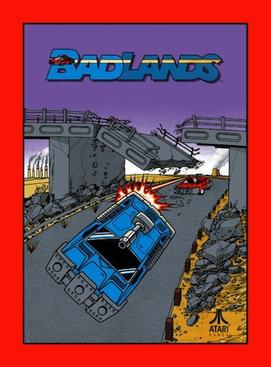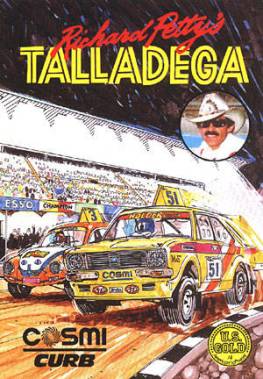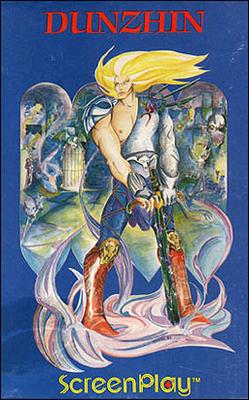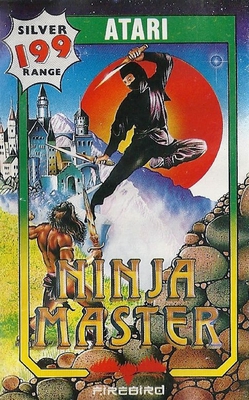
Mail Order Monsters is an action-strategy computer game created by Paul Reiche III, Evan Robinson, and Nicky Robinson. It was published by Electronic Arts for the Commodore 64 in 1985, then released for Atari 8-bit computers in 1986. Players create monsters which they can use to battle multiplayer or against computer-controlled opponents.

Road Runner is a racing video game based on the Wile E. Coyote and Road Runner shorts. It was released in arcades by Atari Games in 1985.

Badlands is a 1989 arcade video game published by Atari Games. It was ported by Domark under the Tengen label to the Amiga, Amstrad CPC, Atari ST, Commodore 64, and ZX Spectrum. The game is a re-themed version of Atari's previous racing games Super Sprint and Championship Sprint with the addition of vehicular combat. Badlands is set in the aftermath of a nuclear war and races around abandoned wastelands with many hazards. Three gun-equipped cars race around a track to win prizes.

Aztec Challenge refers to either of two early action video games published by Cosmi, as well as two subsequent remakes. In all game versions the player takes control of a running Aztec warrior. The first was a side-scrolling platform-jumping game created by Robert Tegel Bonifacio and released in 1982 for Atari 8-bit computers. Subsequently, a different game with the same title and overall theme was created by Paul Norman and released for the Commodore 64. It includes a level in a modified-first-person 3D-style.

Dandy is a dungeon crawl maze video game for Atari 8-bit computers published by the Atari Program Exchange in 1983. It is one of the first video games with four-player, simultaneous cooperative play. Players equipped with bows and unlimited arrows fight through a maze containing monsters, monster spawners, keys, locked doors, food, and bombs in search of the exit leading to the next level. If a player dies, they can be revived by finding and shooting a heart. The game includes an editor for making new dungeons.

Black Lamp is a platform game, originally published by Firebird Software for the Amiga, Atari ST, Commodore 64 and ZX Spectrum computers in 1988, and later published by Atari Corporation for the Atari 8-bit computers in 1989.

Paul Norman is an American game designer, musician, composer, and computer programmer. He has been active in the music scene since 1970 and has been involved with the development of computer entertainment and information since 1982, including the production of Forbidden Forest in 1983.

Panther is a Commodore 64 game designed and implemented by Peter Adams and published by Mastertronic in 1986. A version for Atari 8-bit computers followed in 1987, then a ZX Spectrum port in 1989. The player pilots a strange-looking aircraft, fighting off hordes of invading flying saucers and rescuing people by landing the craft and waiting for them to board. The game uses a diagonally scrolling isometric view, much like Zaxxon and Blue Max, using shadows to show the height of flying objects. Adams previously worked on ports of both of those games.

Richard Petty's Talladega is a racing game featuring Richard Petty and Talladega Superspeedway. It was published by Cosmi in 1984 for Atari 8-bit computers. A Commodore 64 port followed in 1985. It is the first home video game to feature NASCAR racers.

Barbarian II: The Dungeon of Drax is a video game first published in 1988 for various home computers. It was released as Axe of Rage in North America. The game is the sequel to Barbarian: The Ultimate Warrior, which was published in 1987. In Barbarian II, the player controls a princess or barbarian character, exploring the game world to locate and defeat an evil wizard. The game's plot is an extension of its predecessor, although the gameplay is different. While the first game offers two players the opportunity for virtual head-to-head combat, the second is a single-player beat 'em up with fewer fighting moves. It uses a flip-screen style instead of scrolling.

Cops 'n' Robbers is a video game published by Atlantis Software in 1985 for the VIC-20 and in virtually identical form on the Commodore 64. It was ported to the Commodore 16 and Commodore Plus/4 (1986), Acorn Electron and BBC Micro (1987), and Atari 8-bit computers (1988). The game was controversial when released as the player takes the role of a robber and must shoot the police.

Warrior of Ras: Volume I - Dunzhin is a fantasy role-playing video game developed by Med Systems Software. It was released on the TRS-80 in 1982, then ported to the Apple II, Atari 8-bit computers, and Commodore 64. A self-booting IBM PC port added digitized speech.

Leader Board is a series of golf simulation video games that was developed by Bruce Carver and Roger Carver, and published by Access Software.
Cosmi Corporation (COSMI) is an American computer software company based in Carson, California.

Zorro is a puzzle-platform game written by James Garon and published by Datasoft in 1985. Versions were released for the Apple II, Atari 8-bit computers, Commodore 64, and Amstrad CPC. A ZX Spectrum port was published in 1986 by U.S. Gold.

Ninja is a beat 'em up game developed by Sculptured Software and released by Mastertronic in 1986 for the Atari 8-bit computers, Commodore 64, and ZX Spectrum, then in 1987 for the Amstrad CPC, Amiga, Atari ST, and MS-DOS. An arcade version of the game was released in 1987 for Mastertronic's Arcadia Systems which is based on Amiga hardware. The Amiga, Atari ST, and Arcade versions were released as Ninja Mission. As a Ninja, the player attacks a fortress made of individual fixed screens which can be explored non-linearly.

Who Dares Wins II is a run and gun video game developed and published by Alligata Software and released in late 1985 for the Commodore 64, as well as the Amstrad CPC, Atari 8-bit computers, BBC Micro, Commodore 16, Plus/4, MSX, and ZX Spectrum.

The Scrolls of Abadon is a maze video game designed by Frank Cohen and published in 1984 by Access Software for Atari 8-bit computers and Commodore 64.

Ninja Master is an action game depicting ninja training which was published in 1986 for various 8-bit home computers by the Firebird Software silver label. The game was developed by Tron Software and was poorly received by reviewers. A sequel, Oriental Hero, was developed by the same company and released in 1987.



















